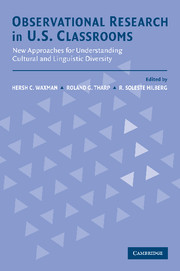 Observational Research in U.S. Classrooms
Observational Research in U.S. Classrooms Published online by Cambridge University Press: 23 November 2009
The purpose of this book is to provide researchers, scholars, and educators with examples of recently developed classroom observation instruments based on current research on effective teaching practices, many developed explicitly for use in today's culturally and linguistically diverse classrooms. The chapters describe several new instruments and include examples of how they have been used to examine effective instruction, schools, and school-based reform models in classrooms and schools with diverse students. Although most observational research in culturally and linguistically diverse settings has been qualitative, systematic classroom observation research has been widely used during the past three decades (Waxman, 1995; Waxman & Huang, 1999). And, although findings from that research have led to a substantive knowledge base on effective teaching practices (Brophy & Good, 1986; Waxman & Walberg, 1982), many critics have argued that systematic observation lacks a theoretical/conceptual framework and merely focuses on discrete categories or small segments of observable teacher behaviors that can be easily measured with observation instruments (Ornstein, 1991). Indeed, most of the early observation instruments focused on direct instruction and easily quantifiable behaviors associated with basic skills instruction, rendering them inappropriate, or when used alone inadequate, for examining today's diverse classrooms. Today, researchers and educators need instruments based on the most recent theoretical/conceptual work and empirical research on effective pedagogy (Tharp, Estrada, Dalton, & Yamauchi, 2000; Waxman & Walberg, 1999). This book presents a rich variety of such instruments.
To save this book to your Kindle, first ensure [email protected] is added to your Approved Personal Document E-mail List under your Personal Document Settings on the Manage Your Content and Devices page of your Amazon account. Then enter the ‘name’ part of your Kindle email address below. Find out more about saving to your Kindle.
Note you can select to save to either the @free.kindle.com or @kindle.com variations. ‘@free.kindle.com’ emails are free but can only be saved to your device when it is connected to wi-fi. ‘@kindle.com’ emails can be delivered even when you are not connected to wi-fi, but note that service fees apply.
Find out more about the Kindle Personal Document Service.
To save content items to your account, please confirm that you agree to abide by our usage policies. If this is the first time you use this feature, you will be asked to authorise Cambridge Core to connect with your account. Find out more about saving content to Dropbox.
To save content items to your account, please confirm that you agree to abide by our usage policies. If this is the first time you use this feature, you will be asked to authorise Cambridge Core to connect with your account. Find out more about saving content to Google Drive.